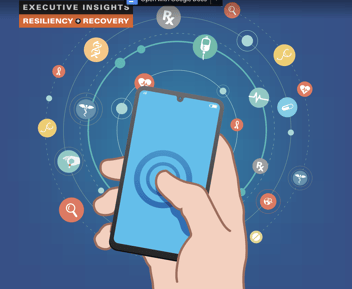Like many others in attendance at the CHIME Fall Forum this November, it was the first conference I have been to since the beginning of the COVID pandemic. For me, it created a blended positive feeling of novelty and nostalgia—“Wow, this is energizing,” combined with, “Oh yeah, this is how we used to do things!” It was delightful!
It was refreshing to hear directly from the healthcare CIOs about their “roses and thorns.” I wanted to share four of the themes and take-aways with you here:
- The changing role of the CIO
- The current state of digital and mobile
- A modern approach for how organizations decide on technology to solve problems
- And the large burdens we have placed on hospital staff and front-line providers.
First and foremost, one overwhelming theme of the conference was the role of the CIO is evolving rapidly from a tactical to a strategic role. Gone are the days when you only needed to keep the printers running. Now, there are myriad hardware and software solutions deployed in every corner of the enterprise, and they are all networked. They are mission critical, and expensive, and more come online every day! A modern CIO is inherently part of the strategic planning of the organization, and their contribution is enormously valuable. I would argue this was always true, and the tsunami of digital tools and solutions has forced everyone to finally realize the true role and value of the hospital CIO. If you are a CIO you are nodding your head right now.
This evolution is in addition to the challenges that CIOs face all the time—security, vendor management, internal stakeholder satisfaction, and maintaining relevance with employees, patients, and their families by deploying state-of-the-art technology.
The second big take away from the conference is the change in the role of the mobile phone and acceptance of mobile as a primary conduit of the patient journey. The pre-pandemic zeitgeist around digital, and especially mobile was, “Mobile is coming, we need to start thinking about it.” Early-adopters were trying new things, and many organizations were watching to see what would happen. Then, it happened.
Post-pandemic the message has changed to, “Mobile is here and we need to catch up!” The future arrived like it so often does—slowly at first, then suddenly, all at once. Shameless plug: At Gozio we’ve been part of this future for many years now, and we are always honored when a client chooses our platform and joins us, and the rest of our clients in that future that focuses on patient and family engagement through a premium native mobile experience.
A third theme was the emergence and proliferation of the cross-functional digital strategy team. This was highlighted by Donna Roach from the University of Utah as she shared with us how her “DEC or Digital Enablement Committee” was carefully formed. The DEC helps their system make smart strategic decisions about technology. Cross-functional executive teams like this are critical for all stakeholders to weigh in on big digital initiatives strategically. At Gozio many of our customers have teams or committees like this, and when we engage with them, it’s always rewarding, because we know the client is approaching their digital strategy holistically and thoughtfully. They’re going to win.
The last and most important theme was about staff, especially nurses and doctors. In several sessions, people highlighted how we have put a lot of the digital revolution “on the backs” of staff. Staff who are already overworked and burning out. “Here is more technology for you to utilize” is a dangerous thing to tell staff right now. The importance of finding smart ways to use digital tools to reduce the administrative load on staff was highlighted. Hospital staff are still under tremendous strain. Many have left their profession as a result, which is bad. We need their knowledge and care to keep us healthy. Which means we need to care for them and reduce the burdens we place on them as a result of new technology constantly entering their workflows. Thus the big message to CIOs, and all hospital leaders was,
“Take care of your staff, and they’ll take care of everything else.”
I was honored and humbled to be part of this conference and see the energy, sincerity, and passion that drives all the CIOs out there to find ways for their hospital to be the best. I was reminded once again that we have come a long way, have a long way to go, and are committed to shared success.


